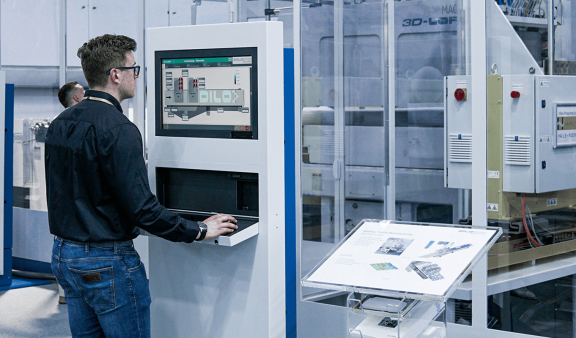
Enabling B2B E-Commerce Success with a Flexible Technology Architecture
Unlocking data across silos and improving the customer experience in all its facets requires an architecture that supports constant change.
Technology should continuously enable the business by allowing it to anticipate new trends and customer needs. However, many B2B companies are still stuck with a rigid architecture. The big challenge is embracing change.
Shift happens
By its very nature, architecture is what you want to change the least since it’s the hardest and most costly thing to change for your organization. That’s why changes in the ecosystem can create real problems for software architecture, especially enterprise. The more things change, the less possible it becomes to do long-term planning. Predictability gets lost. How can you have a five-year plan for your architecture when it can be easily overthrown by some unfathomable innovation? Or, when you anticipate timely as an early adopter, you could end up betting on the wrong horse. When the shift happens, you’ll still need to plan the whole ecosystem that follows. The only solution is to replace your monolithic architecture that is centered around a full-suite solution and build an architecture that anticipates change and evolution in a cost-efficient way.
Going headless for better experiences
As a technology approach, headless keeps change and evolution foremost in mind. Separation of the customer-facing front-end from the back-end layer is essential to a headless approach. With headless commerce, the front-end and back-end of the webshop operate separately from each other. This gives you the ability to scale better and connect new channels – or heads – much more quickly. In practice, the architecture grows evolutionary alongside the customer needs and organizational capabilities.
At the front-end, headless allows your products, videos, blogs and rich content to be presented and shared on any channel. Your content can be delivered anywhere and everywhere, blended with commerce. APIs integrate the back-end systems with the front-ends, allowing data to flow freely in both directions. That enables data integrity and a 360-degree customer view, through which you can make product recommendations, advertise using retargeting and execute personalized marketing campaigns that stretch over different touchpoints.
A headless approach enables companies to improve customer experiences quicker and is considered the future of commerce. But going headless also comes with its cons. You need to build the front-end from scratch, which requires additional IT resources and puts developers behind the steering wheel. That means that even small changes requested by your marketing department for a campaign landing page result in a ticket for the IT department. This not only slows down marketing efforts, but also stifles innovation as the IT department is kept busy with operational requests.
Composable Commerce for more control
Where headless separates front- and back-end, composable commerce breaks everything down to packaged business capabilities (PBC). These are business functions like search, payment, shopping cart and filter options, easily recognizable by business users. Through the API economy, these functions are available via the cloud as a SaaS, which you can easily integrate into your composable architecture. It basically works like LEGO, allowing you to build a commerce experience that is connected and that differentiates your brand. The composable approach is the best-of-breed approach taken to the atomic level.
Of course, the composable architecture also comes with its requirements. You can easily end up using tens of different applications, which requires additional management and orchestration. And while composable puts the business needs first through PBCs, you need to know precisely how you want to shape your commerce experience. Composable gives you maximal freedom, but also comes with maximal responsibility.
Best practices to address the architectural challenge
Let the business lead
Whatever architecture you choose – monolithic, headless or composable – it comes with pros and cons that the business should consider, not only the IT department. That requires a strong business vision of the current trends on your customer needs today and tomorrow, and the capabilities of the organization. You may find that a full-suite solution covers your needs fully or that starting with decoupling your front- and back-end is the quickest way to improve the B2B customer experience.
Emphasize connectivity
There are various solutions available that address specific business needs. PIM for product information, MDM for data management, CDP for creating customer profiles and DXP for delivering digital experiences, for example. Each system stands for a different philosophy and approach to consider. What they have in common is that they all need data, which requires connectivity.
Make multidisciplinary choices
Putting the business in charge does not mean letting go of the views and concerns of your IT department. Where the business may expect the webshop to be fast and full of innovations within months, the IT department will point at all the extra IT resources required to get there. This principle applies to every department in the organization: changing the architecture affects the processes it enables and the people who work with it. Without their support, your ambitious plans may not succeed.

Whitepaper
Overcoming the 4 Key Challenges to your B2B E-Commerce Success
Identify and address the bottlenecks preventing your organization from reaping the maximal benefits of B2B e-commerce.
Customer Case
Read the full case hereGrowth Foundation for Sligro
Sligro Food Group wanted to replace its current E-commerce platform. The platform was vertically divided among their main brands: Sligro, Sligro ISPC, and Van Hoeckel with different levels of digital maturity. This rigid architecture limited Sligro’s capabilities to bring new initiatives to the market fast. In line with Sligro's strategy & growth ambitions, SQLI implemented a scalable solution that allows new formulas to be brought to the market fast. Including a full e-commerce and engagement solution, integrated with data and analytics to enable personalization and segmentation. Sligro’s ambition to grow its presence outside of The Netherlands is now supported by an evolutionary architecture due to its modular components based on SAP Commerce (CX) and Adobe AEM.
Our blended teams worked together on the design of the solution, matching existing functionality while exploring new opportunities. This resulted in a user-centric and technically feasible design, balancing business value with project impact.
“Today’s customer wants to find inspiration online and then order directly for the next day. This platform combines offline self-service with e-commerce in one integrated customer experience.”
Dirk van Iperen, Delivery Director at Sligro Food Group
Want to learn more about flexible technology architectures?
If you want to deep dive into the headless approach for your B2B commerce, check out our blog The choice for headless commerce. If you want to learn more about the composable approach, you can check out our article When is it worth considering composable commerce?.
This is the seventh blog of our article series on B2B e-commerce. Click here for the next article.
Curious to learn more?
Get in touch to discuss how we can drive your B2B E-commerce success.
Contact Us

